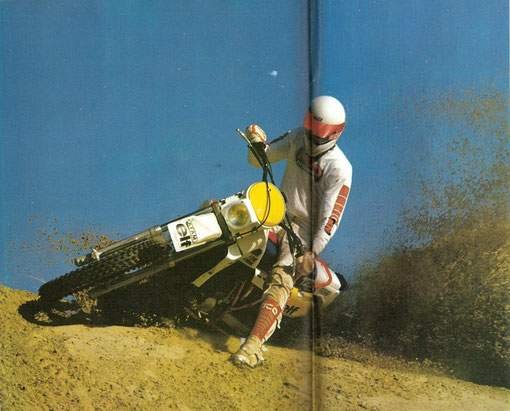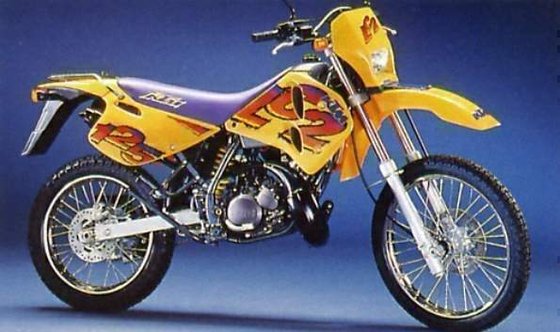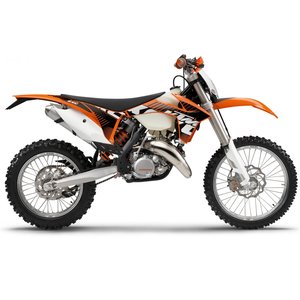KTM 125 EXC (1995-1997): A Lightweight Enduro Legend Revisited

Introduction
The KTM 125 EXC, produced between 1995 and 1997, remains a cult favorite among enduro enthusiasts. This two-stroke machine emerged during an era when lightweight, high-revving dirt bikes began redefining off-road performance. Designed for riders who valued agility and raw power delivery, the 125 EXC carved its niche as a competitive enduro weapon. But how does it hold up today? Let’s strap on a helmet, kickstart this Austrian legend, and explore its strengths—and quirks—from the saddle.
Design & Ergonomics

The KTM 125 EXC’s design screams purpose-built efficiency. Its steel chromoly frame and aluminum subframe strike a balance between durability and weight savings, resulting in a dry weight of just 94.5 kg (208 lbs). For taller riders, the seat height of 949 mm (37.4 inches) might feel slightly intimidating at first, but the narrow profile and well-positioned footpegs create a natural riding triangle. Standing up on the pegs feels effortless, thanks to the bike’s compact wheelbase (1430 mm / 56.3 in) and slim fuel tank.
The bodywork is minimalist—no flashy plastics here. Instead, you get functional touches like a high-mounted front fender (to avoid mud clogging) and a durable skid plate. Ground clearance sits at 381 mm (15 in), allowing the bike to glide over logs and rocks without hesitation.
Engine & Performance
At the heart of the 125 EXC lies a liquid-cooled, two-stroke single-cylinder engine displacing 124.8 cc. With a 54 x 54.5 mm bore and stroke and a 12.5:1 compression ratio, this engine is tuned for aggressive power delivery. The Dell’Orto 37 mm flat-slide carburetor ensures crisp throttle response, though jetting requires careful attention—a common theme in two-stroke ownership.
Power Delivery:
- Low-End: Surprisingly tractable for a 125. You can lug the engine at lower RPMs without stalling, a rarity in this class.
- Midrange: This is where the fun begins. Crack the throttle, and the KTM surges forward with a sharp hit, demanding quick upshifts.
- Top-End: The party doesn’t stop. At 7,500 RPM, the engine screams to its 11 hp peak, urging you to chase the redline.
Riding the 125 EXC is a masterclass in momentum management. It rewards aggressive throttle work and precise gear changes, especially on climbs. The six-speed transmission features wider ratios than its MX sibling, with sixth gear topping out around 120 km/h (75 mph)—enough for connecting trails or short highway stretches.
On the Trail
In Tight Terrain:
The KTM’s weight—or lack thereof—shines here. Flicking it through switchbacks or threading between trees feels like piloting a mountain bike. The engine’s low-end grunt lets you crawl over roots and rocks, while the hydraulic clutch offers smooth modulation.
Open Trails & Hill Climbs:
Pin the throttle, and the 125 EXC transforms. The rear tire breaks traction eagerly, but the lightweight chassis lets you correct slides with a knee or a quick weight shift. Steep climbs demand commitment: downshift early, keep the RPMs high, and trust the Pro Lever/WP monoshock (later models) or Ohlins Type 3A rear shock to soak up kickback.
Suspension:
- Front: The 43 mm Marzocchi Magnum 45 USD forks (1996 onward) improved significantly over earlier models. They handle square-edged ruts and small jumps admirably, though heavier riders might crave stiffer springs.
- Rear: The fully adjustable Ohlins shock is a standout, offering plush initial travel and progressive damping. It’s leagues ahead of competitors’ setups.
Brakes:
Later models swapped drum brakes for a 260 mm front disc and 220 mm rear disc. While not as powerful as modern systems, they provide consistent stopping power once warmed up.
Competition
In the mid-’90s, the 125 EXC faced fierce rivals:
- Husqvarna 125 WXE
- Similar weight and power but with a narrower powerband.
-
Husky’s suspension was plusher in stock form, but the KTM’s Ohlins shock leveled the field.
-
Yamaha WR125Z
- More beginner-friendly with a linear power delivery.
-
Heavier by 7 kg (15 lbs), making it less agile in technical sections.
-
Honda CR125R (Modified for Enduro)
- The CR’s MX-oriented engine lacked low-end torque.
- Honda’s build quality was superior, but aftermarket parts were costlier.
KTM’s Edge:
- Class-leading suspension components.
- Lighter chassis and sharper handling.
- Easier maintenance (e.g., air filter access).
Maintenance
The 125 EXC is a mechanic’s dream—simple, modular, and overbuilt. Key considerations:
- Engine Rebuilds:
- Two-strokes demand frequent top-end refreshes. Plan for piston replacements every 40–50 hours under hard use.
-
Inspect the powervalve mechanism regularly for carbon buildup.
-
Carburetor Tuning:
-
The Dell’Orto 37 mm carb is reliable but finicky in temperature swings. Keep a selection of main jets (e.g., #210–#220) and experiment with needle positions.
-
Suspension Servicing:
- Replace fork oil every 100 hours to maintain damping consistency.
-
The Ohlins shock benefits from professional bleeding to eliminate air bubbles.
-
Brake Upgrades:
- Older models with drums can retrofit later disc brakes using MOTOPARTS.store’s conversion kits.
Recommended Upgrades from MOTOPARTS.store:
- High-flow air filters for dusty conditions.
- Aftermarket exhaust systems (e.g., FMF Fatty) to broaden the powerband.
- Heavy-duty chains and sprockets.
Conclusion
The KTM 125 EXC (1995–1997) isn’t just a relic—it’s a testament to how thrilling lightweight enduro bikes can be. It demands skill and effort but repays riders with unrivaled agility and a visceral connection to the trail. Today, it remains a viable choice for vintage enduro races or as a nimble trail companion. Whether you’re hunting for a restoration project or upgrading your current EXC, MOTOPARTS.store has the gear to keep this Austrian icon alive and kicking.
Ride hard, shift often, and let the two-stroke symphony play on.
Specifications sheet
| Engine | |
|---|---|
| Stroke: | Two-stroke |
| Ignition: | Kokusan digital |
| Starting: | Kick |
| Max power: | 8 kW | 11.0 hp |
| Fuel system: | Dell'Orto 37 mm flat slide carburetor |
| Max power @: | 7500 rpm |
| Displacement: | 125 ccm |
| Configuration: | Single |
| Cooling System: | Liquid cooled |
| Compression ratio: | 12.5:1 |
| Number of cylinders: | 1 |
| Wheels | |
|---|---|
| Rear wheel size: | 18 inch |
| Front wheel size: | 21 inch |
| Dimensions | |
|---|---|
| Wheelbase: | 1430 mm (56.3 in) |
| Dry weight: | 95 |
| Seat height: | 949 mm (37.4 in) |
| Ground clearance: | 381 mm (15 in) |
| Fuel tank capacity: | 9 L (2.4 US gal) |
| Drivetrain | |
|---|---|
| Final drive: | chain |
| Transmission: | 6-speed |
| Maintenance | |
|---|---|
| Rear tire: | 120/90-18 |
| Front tire: | 90/90-21 |
| Brake fluid: | DOT 4 |
| Gearbox oil: | SAE 10W-40 |
| Spark plugs: | NGK BR8ES |
| Coolant capacity: | 1.2 |
| Forks oil capacity: | 0.8 |
| Gearbox oil capacity: | 0.7 |
| Chassis and Suspension | |
|---|---|
| Frame: | Chromoly steel with aluminum subframe |
| Rear brakes: | Single 220 mm disc, 1-piston caliper |
| Front brakes: | Single 260 mm disc, 2-piston caliper |
| Rear suspension: | Fully adjustable Ohlins Type 3A monoshock |
| Front suspension: | 43 mm Marzocchi Magnum 45 USD fork |
| Rear wheel travel: | 345 mm (13.6 in) |
| Front wheel travel: | 300 mm (11.8 in) |



















